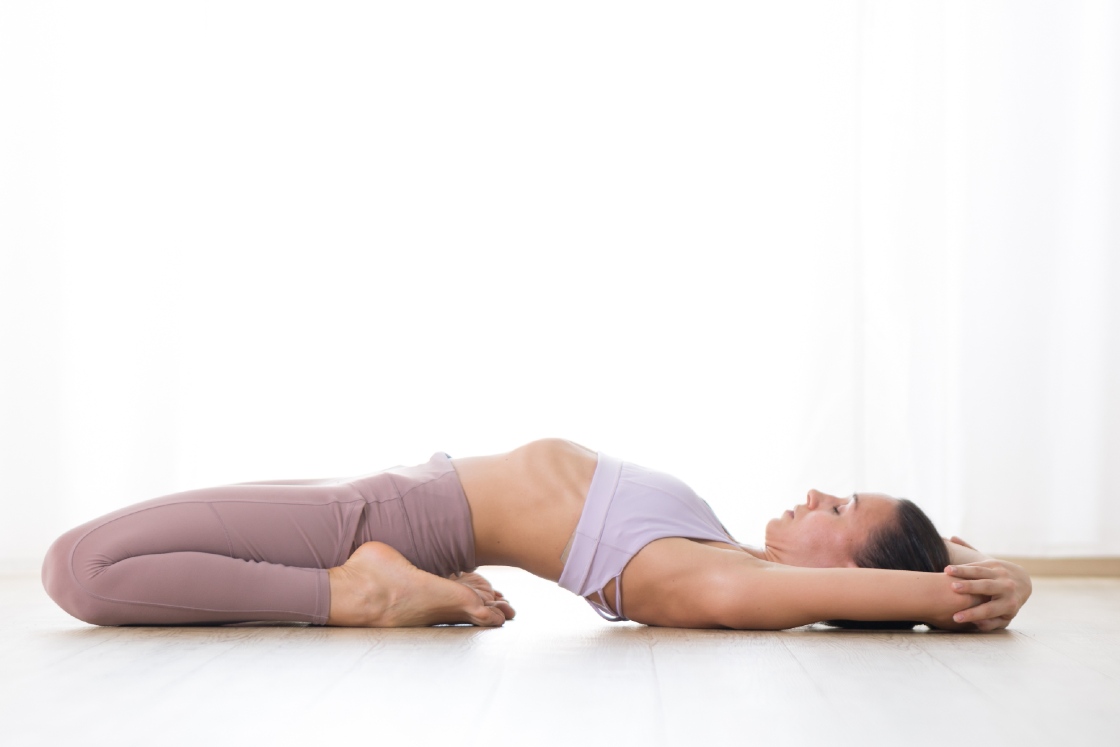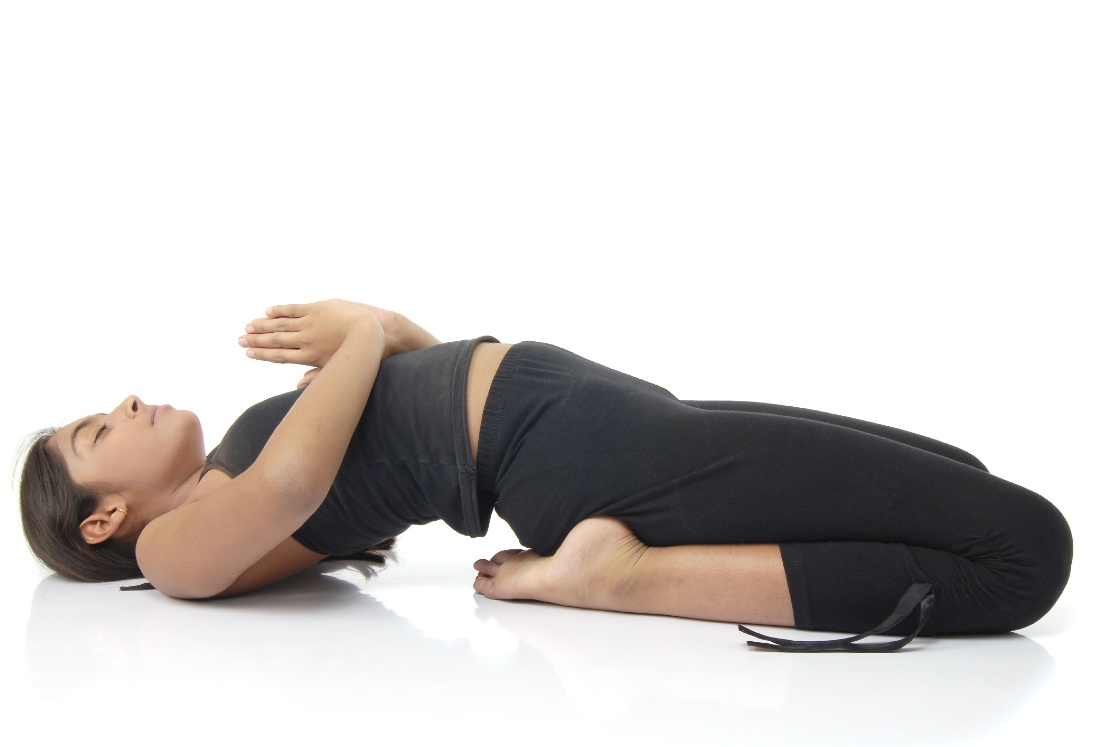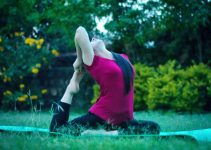- Meaning
- Supta Vajrasana vs. Supta Virasana
- Precautions
- Supta Vajrasana Steps
- Variations
- Supta Vajrasana Benefits

Supta vajrasana is a variant of traditional Vajrasana where the body is reclined in a sleeping position with an arch on the back. It is also known by its English name; reclined thunderbolt pose, sleeping thunderbolt pose, or supine thunderbolt pose. This pose is performed in the supine position.
Supta vajrasana involves deep stretching, reclining, inversion, and strength. It makes the pose very good for women alleviating the menstrual pain and minimizing pregnancy complications.
It involves stretching of the spine, hips, and legs. Besides this, this pose also exercises the chest, neck, and abdominal muscles.
Supta Vajrasana Meaning
The Sanskrit name of this asana is formed of three root terms. Here, ‘supta‘ means ‘reclining‘ or ‘lying down’, ‘vajra‘ is ‘thunderbolt’ or ‘excessively firm’, and ‘asana’ means ‘pose.’
In this posture, the body of the practitioner is kept firm and involves leaning on the back.
The backward leaning helps in the expansion of the chest. This strengthens the lungs. It also stretches the pelvic joint making it more flexible.
Supta Vajrasana vs. Supta Virasana
A simple difference between Vajrasana and Virasana also applies to supta vajrasana and supta virasana.
As in vajrasana the lower legs and heels lie directly under the thigs and buttocks respectively, in supta vajrasana also lower legs and heels remain directly below the buttocks. Whereas, in Supta Virasana lower legs need to be spread adjacent to the buttocks so side heels touch the buttocks only.
Supta Vajrasana Practice Guide
The body resembles in supta vajrasana similar to fish pose (matsyasana), but the difference between fish pose and reclined thunderbolt pose is only of the position of legs. In matsyasana, legs are extended straight in a supine position while in Supta vajrasana, legs are kept in as the base Vajrasana position.
Before we begin Supta Vajrasana practice, go through the following points for safe practice;
Precautions & Contraindications
- Do not perform supta vajrasana if you have an injured knee or back.
- Avoid performing this asana with a broken ankle.
- People having a problem with sciatica, slip disc, and other spinal issues should not practice this asana.
- Never release out of supta vajrasana by straightening the legs first. This may dislocate the knee. Always relax the legs after coming to vajrasana.
- Always perform supta vajrasana on empty stomach.
Preparatory Poses
Supta Vajrasana Steps
- Begin with vajrasana, tucking your legs under the torso, and sitting on your ankles.
- Slowly start leaning backward, bend your lower back taking support from your elbows and forearms.
- Lean back until the head rests on the floor.
- Draw the top of your head to the floor while arching the back. Now release the elbow support from your lower back.
- Bring your hands to your thighs and push the knees towards the floor.
- Keeping the eyes closed maintain the arch back and hold the posture for 30-60 seconds with deep breaths.
- Inhale and lift your head and upper body off the floor taking the support from elbows and forearms.
- Relax in vajrasana.
Beginner’s tips
- Maintain the proper alignment throughout the posture, ensure the hips lie directly in between side heels.
- Keep your ankles straight with the toes pointing backward.
- Do not let your knees to lift off the floor.
- If you feel pain while holding the pose correct the posture depth.
- It might be difficult to sit on your heels initially, but, neither push yourself nor quit. Just perform it within your capacity and slowly work your way into it.
Follow-up poses
Modifications & Props
Supta vajrasana can be modified in easy manner using the following props;
- Bolster – Keep a bolster horizontally at your back. Lean on it and then bring the crown of the head to the floor. This will help in making an arch between your back and neck.
- Yoga strap – If you finding difficulty in keeping the thighs and knees in place wrap a strap around your thighs. This will prevent the thighs from sliding out.
Supta Vajrasana Variations

- Instead of keeping the hands on the thighs, one can extend their hands overhead. Stretch the arms straight on the floor and keep breathing. This will deepen the supta vajrasana.
- Another variation could be to clasp the elbows of opposite hands overhead after attaining supta vajrasana.
- Eka pada supta vajrasana – In this variation, the practitioner keeps one leg under the torso while the other leg is stretched out. The further steps remain the same.
- Ardha Supta Vajrasana – In this pose, keep one leg under the torso and bent the other knee keeping the foot on the floor. Lean back touch the crown of your head to the floor. Lift the foot off the floor and place it over the other thigh tilting the knee outward.
Supta Vajrasana Benefits
1. Enhances flexibility
Supta vajrasana involves the stretching of the chest, abdomen, spine, hips, and leg muscles. By stretching these muscles the asana provides a toned body. It improves the flexibility of the spine, thighs, pelvis, and ankles.
2. Improves posture
Supta vajrasana helps in stretching and strengthening the entire body. It tones the spinal nerves and other muscles. This is also beneficial in improving the alignment of shoulders by correcting rounded shoulders.
3. Facilitates respiration
The leaning backward involved in the asana extends the dorsal region. It opens the chest cavity fully and expands the lungs. It helps in increased oxygen flow into the lungs .Therefore, this asana is beneficial in improving respiration. It also treats lung disorders like asthma, bronchitis, etc.
4. Improves digestion
The abdominal muscles are also stretched while holding the pose. It stimulates the digestive organs and enhances the functioning of the digestive system .
This also removes constipation and other digestive disorders by gently massaging the abdominal organs.
5. Activates vajra nadi
This posture helps stimulate the Vajra Nadi. Among various nadis in our body, vajra nadi helps in controlling sexual energy. It helps in achieving spirituality by diverting this energy.
It also aids in reducing reproductive disorders of male and female. A scientific study, also proves that it is suitable for improving sexual health. It even cures infertility.
Conclusion
Supta Vajrasana is a powerful yoga pose that offers a range of physical and mental health benefits. Its unique combination of deep stretching, reclining, and strength-building makes it a valuable addition to any yoga practice, especially for women. By incorporating Supta Vajrasana into your routine, you can enhance flexibility, improve posture, facilitate respiration, improve digestion, and activate the Vajra Nadi, leading to overall well-being and improved quality of life.




